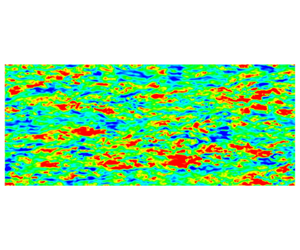Crossref Citations
This article has been cited by the following publications. This list is generated based on data provided by
Crossref.
Huynh, David P.
Huang, Yuting
and
McKeon, Beverley J.
2021.
Experiments and Modeling of a Compliant Wall Response to a Turbulent Boundary Layer with Dynamic Roughness Forcing.
Fluids,
Vol. 6,
Issue. 5,
p.
173.
Flack, Karen
and
Chung, Daniel
2022.
Important Parameters for a Predictive Model ofksfor Zero Pressure Gradient Flows.
Terziev, Momchil
Tezdogan, Tahsin
and
Incecik, Atilla
2022.
Scale effects and full-scale ship hydrodynamics: A review.
Ocean Engineering,
Vol. 245,
Issue. ,
p.
110496.
Garcia-Mayoral, Ricardo
Durbin, Paul
McKeon, Beverley J.
Piomelli, Ugo
Sandberg, Richard D.
Bensow, Rickard
Bettle, Mark
Knopp, Tobias A.
Krumbein, Andreas
Roy, Christopher J.
Gargiulo, Aldo
Lowe, K T.
and
Toxopeus, Serge L.
2022.
Modeling of high-Re, incompressible, non-equilibrium, rough-wall boundary layers for naval applications under NATO-AVT349.
Salomone, Teresa
Piomelli, Ugo
and
De Stefano, Giuliano
2022.
Wall-Modeled and Hybrid Large-Eddy Simulations of the Flow over Roughness Strips.
Fluids,
Vol. 8,
Issue. 1,
p.
10.
Flack, Karen A.
and
Chung, Daniel
2022.
Important Parameters for a Predictive Model of ks for Zero-Pressure-Gradient Flows.
AIAA Journal,
Vol. 60,
Issue. 10,
p.
5923.
Varghese, Joel
and
Durbin, Paul A.
2022.
Representation of Surface Roughness in Hybrid Turbulence Simulations.
Flow, Turbulence and Combustion,
Vol. 109,
Issue. 2,
p.
255.
Durbin, Paul A.
2023.
Reflections on roughness modelling in turbulent flow.
Journal of Turbulence,
Vol. 24,
Issue. 1-2,
p.
3.
Ismail, Umair
2023.
Direct Numerical Simulation of a Turbulent Boundary Layer Encountering a Smooth-to-Rough Step Change.
Energies,
Vol. 16,
Issue. 4,
p.
1709.
Bucquet, Quentin
Calmet, Isabelle
Perret, Laurent
and
Maché, Magdalena
2023.
Large-eddy simulation of the urban boundary layer using drag-porosity modeling.
Journal of Wind Engineering and Industrial Aerodynamics,
Vol. 238,
Issue. ,
p.
105432.
Zhou, Zhideng
Li, Shilong
He, Guowei
and
Yang, Xiaolei
2024.
A data-driven distributed force model for wall-modeled large-eddy simulations of rough-wall turbulence.
Journal of Computational Physics,
Vol. 514,
Issue. ,
p.
113241.
Salomone, T.
Piomelli, U.
and
De Stefano, G.
2024.
Direct and Large Eddy Simulation XIII.
Vol. 31,
Issue. ,
p.
368.
García-Mayoral, Ricardo
Chung, Daniel
Durbin, Paul
Hutchins, Nicholas
Knopp, Tobias
McKeon, Beverley J.
Piomelli, Ugo
and
Sandberg, Richard D.
2024.
Challenges and perspective on the modelling of high-Re, incompressible, non-equilibrium, rough-wall boundary layers.
Journal of Turbulence,
Kadivar, Mohammadreza
and
Garg, Himani
2025.
Turbulent Heat Transfer over roughness: a comprehensive review of theories and turbulent flow structure.
International Journal of Thermofluids,
Vol. 26,
Issue. ,
p.
100967.
Braga, Mateus A.
and
Macdonald, Robyn L.
2025.
A Study of Hypersonic Blunt Bodies With Roughness Using WRLES.
